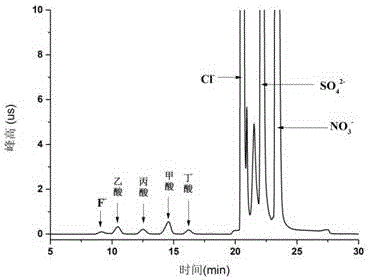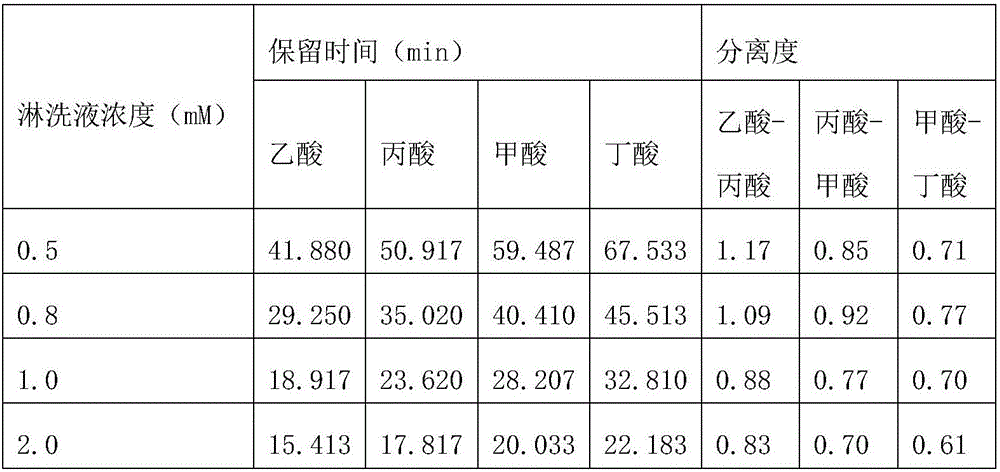Detection method of organic acids in environment
A detection method and technology for organic acids, which can be used in measurement devices, instruments, scientific instruments, etc., can solve the problems of low concentration, high detection limit, non-linearity, etc., and achieve the effect of simple pretreatment and low detection limit.
- Summary
- Abstract
- Description
- Claims
- Application Information
AI Technical Summary
Problems solved by technology
Method used
Image
Examples
Embodiment 1
[0029] Embodiment 1: the determination of elution program and analysis condition
[0030] Design and select the appropriate eluent concentration and flow rate. The goal of the second stage is to elute strongly retained ions such as Cl-, SO42-, NO3-, etc. Based on the experimental experience of detecting inorganic anions, the KOH concentration is set to 30mM. Under this condition, the strongly retained ions It can be completely eluted, so only the concentration of eluent in the first and third stages needs to be discussed. The effects of KOH concentrations of 0.5, 0.8, 1.0, 1.2mM and flow rates of 0.5, 1.0, 1.2mL / min on retention time and resolution were investigated. The experimental results are shown in Table 1, Table 2 and Table 3.
[0031] Table 1 The retention time and resolution of each substance under different eluent concentrations when the flow rate is 0.5mL / min
[0032]
[0033] Table 2 The retention time and resolution of each substance under different eluent co...
Embodiment 2
[0049] Example 2: Linearity, detection limits and precision of the method
[0050]The corresponding mixed standard series solutions were prepared from the standard stock solutions of each component, and analyzed according to the chromatographic detection conditions described in Example 1. According to the retention time qualitative, the peak area external standard method quantitatively obtained the linear regression equation and the correlation coefficient of each component. The reagent blank of this method is ultrapure water, and acetic acid, formic acid, propionic acid, and butyric acid were not detected in the reagent blank. Therefore, the detection limit of the method was calculated according to the provisions of the HJ168-2010 standard according to the whole steps of sample analysis.
[0051] The standard stock solution of described formic acid, acetic acid is made into the standard stock solution of 1000m / L with chromatographically pure formic acid, acetic acid reagent (...
Embodiment 3
[0057] Embodiment 3: the anti-interference experiment of method
[0058] Add a certain amount of F to the standard solution of formic acid, acetic acid, propionic acid and butyric acid - , Cl - , SO 4 2- , NO 3 - To test the feasibility and accuracy of the organic acid detection method. The result shows F - , Cl - , SO 4 2- , NO 3 - The retention times are 9.193, 20.473, 22.137 and 23.470min respectively, such as figure 1 shown. Therefore, the high concentration of Cl in the sample - , SO 4 2- , NO 3 - Does not interfere with the detection of formic, acetic, propionic, and butyric acids. f - The retention time of acetic acid is closer to the retention time of 10.743min before acetic acid, but usually the F in water samples - The content is low and will not interfere with the detection of acetic acid. When F - When the content is high, the acid can be tested for spiked recovery to ensure the accuracy of the test results.
PUM
 Login to View More
Login to View More Abstract
Description
Claims
Application Information
 Login to View More
Login to View More - R&D
- Intellectual Property
- Life Sciences
- Materials
- Tech Scout
- Unparalleled Data Quality
- Higher Quality Content
- 60% Fewer Hallucinations
Browse by: Latest US Patents, China's latest patents, Technical Efficacy Thesaurus, Application Domain, Technology Topic, Popular Technical Reports.
© 2025 PatSnap. All rights reserved.Legal|Privacy policy|Modern Slavery Act Transparency Statement|Sitemap|About US| Contact US: help@patsnap.com



